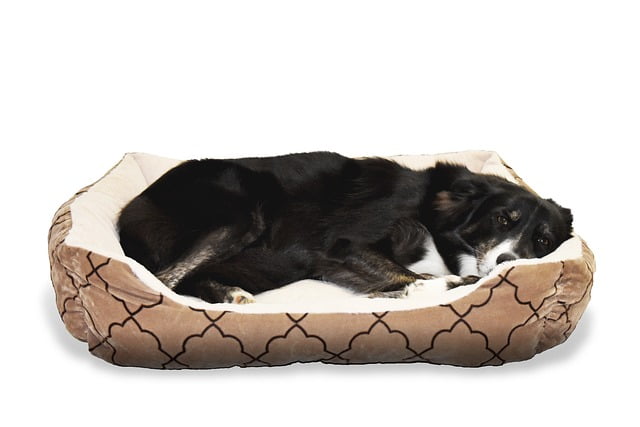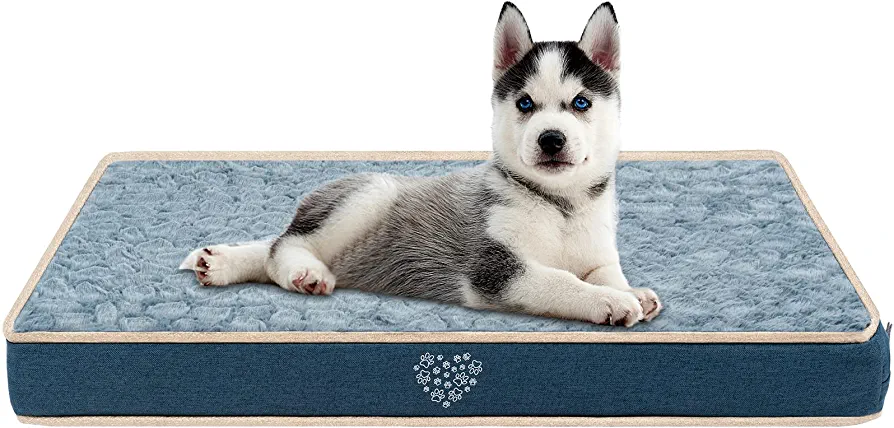Why do dogs sleep with their bum facing you?
Dogs are known for their unique sleeping positions. They can sleep curled up in a ball, stretched out on their backs, or even upside down. One common sleeping position that dogs often choose is with their bum facing their owner. Many dog owners have wondered why their furry friends sleep in this peculiar position. In this article, we will look at some of the reasons why dogs sleep with their bum facing you and other sleeping positions that dogs often adopt.
Related articles:
- Why does my dog hide under the bed and growl?
- Why do dogs rub their nose on the bed?
- Should I give my dog a treat before bed?
Why do dogs sleep with their bum facing you?
Here are some of the reasons why dogs sleep with their bum facing you:
For protection and Security
Dogs are pack animals, and they seek comfort and security in their pack. When they sleep, they often choose a position that allows them to feel protected and secure. Sleeping with their bum facing you allows them to keep an eye on their pack leader, which is you. From a canine behaviorist’s perspective, this position shows that your dog trusts you and sees you as their protector.
Learned behavior
Dogs may sleep with their bum facing you simply because they have learned that this is a behavior that pleases their owner. If you have previously shown your dog affection or given them treats when they sleep in this position, they may continue to do so to seek your approval.
Comfort and affection
Another reason why dogs may sleep with their bum facing you is that they feel comfortable and safe around you. Dogs have a keen sense of smell, and they often associate familiar scents with comfort and safety. Your dog may be drawn to your scent and feel comforted by it, which is why they choose to sleep with their bum facing you.
Temperature regulation
Dogs regulate their body temperature through their paws and the bottom of their belly. Sleeping with their bum facing you may help regulate their temperature more effectively.
Common misconceptions about dogs sleeping with their bum facing you
There are several misconceptions that people often have about dogs sleeping with their bum facing them. Here are some of the most common misconceptions:
“It means they are asserting dominance”:
One of the most pervasive myths about dogs sleeping with their bums facing their owners is that it is a sign of dominance. However, this is not true. Dogs do not view their owners as fellow dogs in a pack, and they do not engage in dominance behavior towards them.
“It means they are uncomfortable”:
Some people assume that if a dog is sleeping with their bum facing them, it must mean that they are uncomfortable and seeking space. However, this is also not necessarily true. Dogs have their own preferences when it comes to sleeping positions, and some simply prefer to sleep with their bum facing their owners.
“It means they don’t respect you”:
Another common misconception is that if a dog sleeps with their bum facing their owner, it means they don’t respect them. This is not true either. Dogs do not have the capacity to understand or exhibit human concepts of respect.
“It’s a sign of affection”:
While it is true that some dogs may sleep with their bum facing their owners as a sign of affection, it is not a universal behavior. Some dogs may prefer to sleep in other positions, and the position they choose does not necessarily reflect their feelings towards their owner.
“It’s a sign of anxiety or fear”:
Finally, some people assume that if a dog sleeps with their bum facing them, it must mean that they are anxious or fearful. While this may be the case for some dogs, it is not a reliable indicator of anxiety or fear. Dogs may adopt a variety of sleeping positions for a variety of reasons, and it is important to look at their behavior as a whole to determine their emotional state.
Other sleeping positions
In addition to sleeping with their bum facing you, dogs have other common sleeping positions. For example:
- Curled up: One of the most frequently observed sleeping positions for dogs is this. When a dog curls up in a ball, they are trying to conserve body heat and protect their vital organs. This position is often used when the dog is feeling cold, anxious, or wants to feel secure. Dogs that sleep in this position generally feel safe and comfortable.
- On their side: When a dog sleeps on their side, they are indicating that they are feeling relaxed and comfortable. This position also allows the dog to regulate their body temperature effectively, and it is often used by dogs that are feeling content and happy.
- On their back: When a dog sleeps sleeps on their back with their paws in the air, they are indicating that they are feeling very relaxed and comfortable. This position is often used by dogs that are feeling very safe and secure in their environment, and it allows them to expose their belly, which is a sign of trust.
- Stretched out: Some dogs prefer to stretch out when they sleep, either on their belly or on their side. This position indicates that the dog is feeling comfortable and relaxed, but also alert and ready to spring into action if necessary.
- Head on paws: Some dogs prefer to sleep with their heads resting on their paws. This position indicates that the dog is feeling comfortable and relaxed but still alert to their surroundings. It is often used by dogs that want to be near their owner while they sleep.
- Tucked under: Finally, some dogs prefer to sleep with their bodies tucked under a piece of furniture or a blanket. This position indicates that the dog is feeling safe and secure, and it allows them to regulate their body temperature effectively.
Factors that influence a dog’s sleeping behavior
Several factors can influence a dog’s sleeping behavior. These factors include:
Age
A dog’s age can affect how much they sleep and their sleeping habits. Puppies, for example, may sleep up to 20 hours a day, while adult dogs may sleep for 12–14 hours. Senior dogs may sleep even more than this as their energy levels decrease with age.
Health
A dog’s health can also affect their sleeping habits. Dogs that are in pain or discomfort may have trouble getting comfortable enough to sleep, while dogs with certain medical conditions may need to sleep more to help their bodies recover.
Breed
Some dog breeds are more active than others, and this can affect how much they need to sleep. For example, working breeds like the Border Collie may need less sleep than breeds like the Bulldog or Basset Hound, which are more prone to obesity and sleep more.
Environment
The environment in which a dog lives can also affect their sleeping habits. Dogs that live in noisy or busy environments may have trouble sleeping soundly, while dogs that live in calm, quiet environments may be able to sleep for longer periods without interruption.
Activity level
A dog’s activity level can affect how much they need to sleep. Dogs that are very active may need more sleep to help their bodies recover, while dogs that are less active may need less sleep.
Routine
Dogs thrive on routine, and this extends to their sleeping habits. Dogs that have a consistent sleeping schedule are more likely to sleep soundly and wake up feeling refreshed, while dogs that have irregular sleeping patterns may have trouble getting enough rest.
Diet
A dog’s diet can also affect their sleeping habits. Dogs that eat a high-quality, balanced diet are more likely to have the energy they need to stay active and alert during the day and sleep well at night.
Owner’s role
The owner’s role is also important in shaping a dog’s sleeping habits. Providing a comfortable and safe sleeping environment is essential. Dogs need a place where they can feel secure and relaxed. This can be a dog bed or a crate with a soft blanket or pillow.
Frequently Asked Questions
Is it normal for dogs to sleep with their bum facing you?
Yes, it is normal for dogs to sleep with their bum facing you. It is a reflection of their comfort level and need for security.
What does it mean when a dog sleeps on its back with its legs in the air?
When a dog sleeps on its back with its legs in the air, it usually means that it is relaxed and confident.
How can I create a comfortable sleeping environment for my dog?
You can create a comfortable sleeping environment for your dog by providing a dog bed or crate with a soft blanket or pillow. Make sure the sleeping area is in a quiet location and free from distractions.
Why are exercise and nutrition important for a dog’s sleeping behavior?
Exercise and nutrition are important for a dog’s sleeping behavior because they help regulate their energy levels and promote relaxation.
Is it normal for dogs to snore while sleeping?
Yes, it is normal for dogs to snore while sleeping. However, if the snoring is excessive or accompanied by other symptoms, it may be a sign of an underlying health issue.
Can dogs have sleep disorders?
Yes, dogs can have sleep disorders. Some common sleep disorders in dogs include sleep apnea, narcolepsy, and REM behavior disorder.
How many hours a day do dogs sleep?
The amount of time dogs sleep can vary depending on their age, breed, and activity level. On average, adult dogs sleep for 12–14 hours per day.
Why do dogs sometimes twitch or move their legs while sleeping?
Dogs may twitch or move their legs while sleeping due to dreaming or REM sleep. There is no need for concern as this behavior is considered normal.
Conclusion
Dogs have unique sleeping positions, and sleeping with their bum facing you is one of them. Like I said earlier, this position is a reflection of their trust and comfort level with their owner. So, you don’t have to worry that there might be something wrong with your dog. A dog’s sleeping position can also reveal their personality or emotional state.


